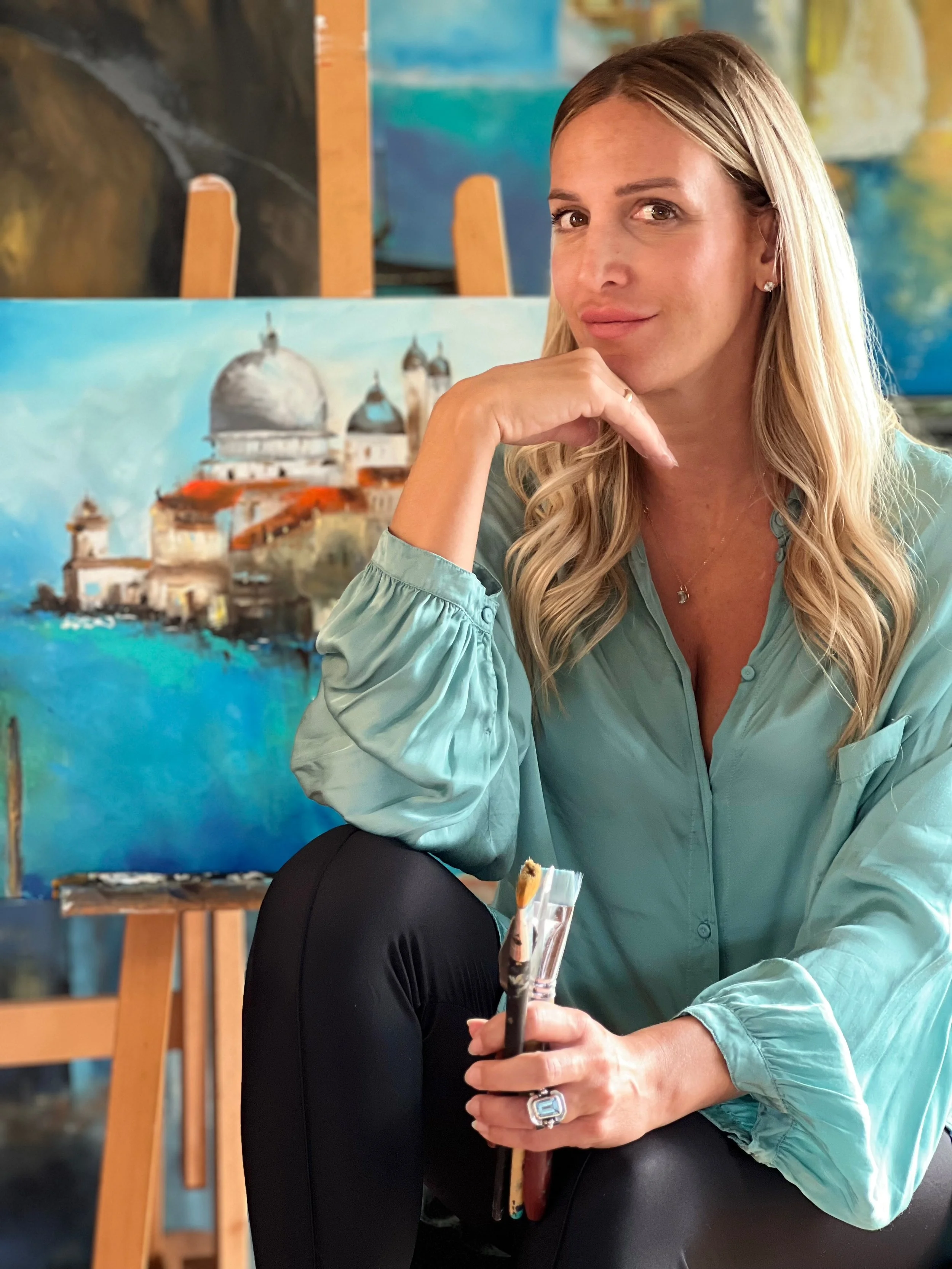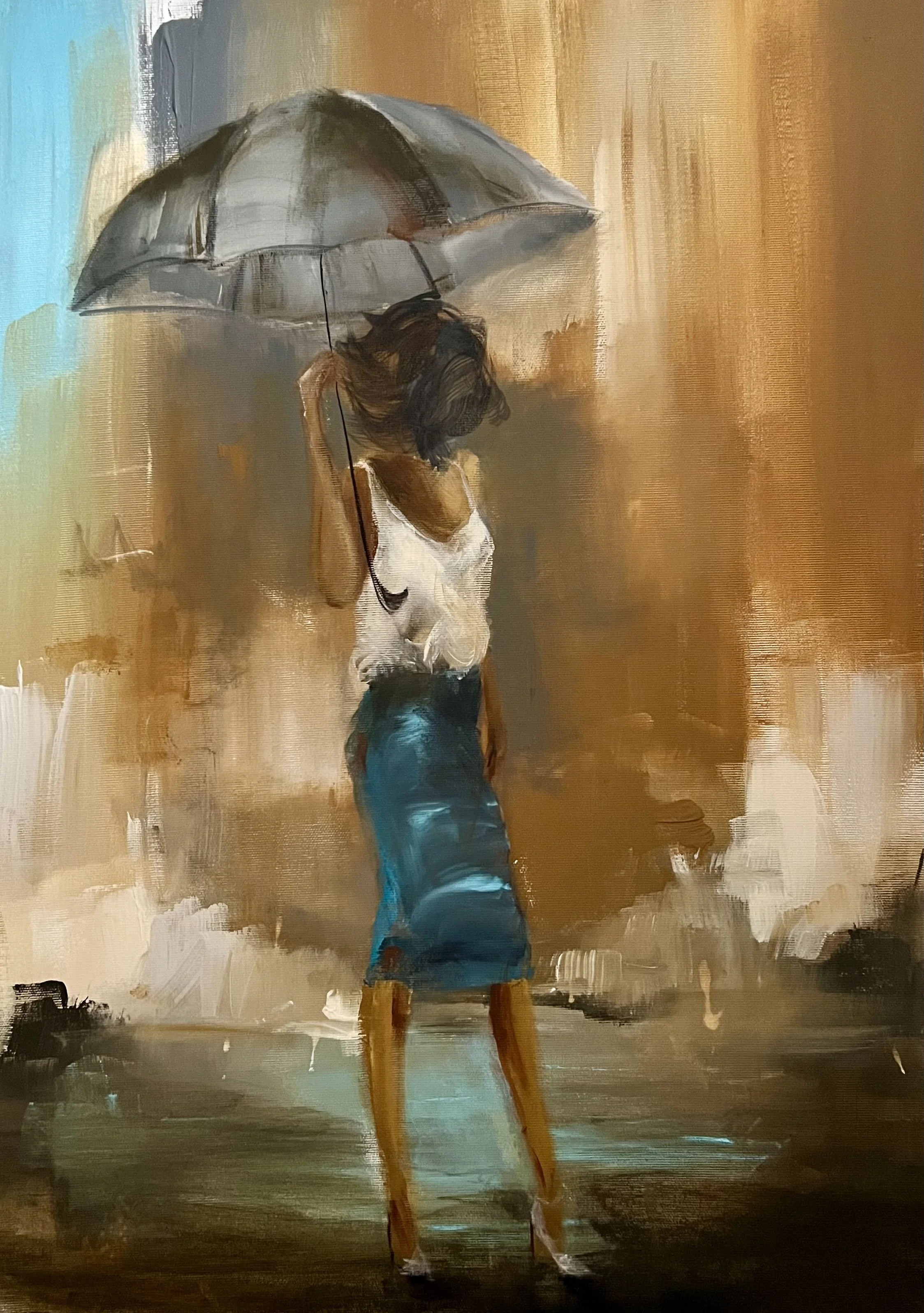Interview with Tamara Andjus
Tamara, your first exhibition at the age of 4 is quite remarkable. Can you share some of your earliest memories of creating art and what it felt like to win a state competition at such a young age? How did these early achievements and experiences shape your perception of art and influence your subsequent artistic journey? Did you have any mentors or influences during your childhood that significantly impacted your development as an artist?
Reflecting on my childhood and the moment I won my first art prize brings back overwhelming memories of joy and satisfaction. At such a young age, one cannot predict what the future will bring. I remember the pride and humility I felt when my work was chosen among so many talented entrees.
It was during my pre-school years when we were given the task of drawing our impressions of "my way to school." I drew a policeman helping children cross the road at a crossroads. Being very shy, this recognition boosted my self-esteem and gave me confidence.
I continued to develop my talent in an art class where I had the opportunity to experiment with many different techniques. My early mentors were kind and supportive, nurturing my fascination with transferring an image onto a piece of paper and the emotions it could evoke. I always enjoyed experimenting and trying new things, pushing myself to improve and move forward. This period was crucial in shaping me into the artist I am today.
You pursued a rigorous academic path in law, earning both a Bachelor and Master's degree, yet your passion for art remained undiminished. Can you elaborate on how you managed to balance the demands of your legal studies and career with your artistic pursuits? Were there specific instances or challenges that made you question your path, and how did you navigate these moments? Additionally, how did your legal background influence your approach to art, if at all?
Studying law didn’t diminish my passion for art and painting. In fact, it enhanced my development as an artist.
Balancing the demands of my legal studies and career with my artistic pursuits required careful time management and dedication. I set aside specific times each week for painting, treating it as a vital part of my schedule. I also found that my legal studies brought structure and discipline to my creative process, while my art provided a much-needed outlet and balance to the rigors of my legal work. By integrating both passions into my daily life, I was able to thrive in both areas.
Your work is characterized by abstract impressionist styles, with a strong emphasis on light, color, and dynamic movement. From a philosophical standpoint, how do you approach your art? What do you believe is the intrinsic role of art in society, and what messages or emotions are you striving to communicate through your paintings? How do you see the interaction between the observer and the artwork, and what kind of impact do you hope your art has on its audience?
I believe that art serves as a medium through which individuals can connect with their emotions, reflect on their experiences, and find meaning in the world around them.
Through my paintings, I strive to communicate emotions and messages that are both deeply personal and universally resonant. I aim to capture moments of introspection, joy, and harmony, inviting viewers to engage with the artwork on an emotional level. The interaction between the observer and the artwork is a dynamic process, where the viewer's interpretation and emotional response complete the artistic experience.
I hope my art can inspire and evoke strong emotions, fostering a sense of connection.
Moving to Zürich and dedicating yourself entirely to art marked a significant transition in your life. What were some of the key challenges you faced during this period of change, both personally and professionally? Can you describe any pivotal moments that reaffirmed your decision to focus on art? How did your family and personal life contribute to or influence this transformative journey?
Adjusting to a new city and building a network from scratch was a big challenge. I had to navigate the complexities of a new environment while trying to establish myself as an artist balancing family obligations and work.
My family played a crucial role in this journey. Their support and encouragement gave me the confidence to pursue my dreams.
In the beginning, after having couple of exhibitions, positive reception and genuine connections I made with the viewers were incredibly validating. Seeing people resonate with my work and hearing their interpretations of my paintings reinforced my belief that I was on the right path.
You’ve received several prestigious awards throughout your career. Could you discuss which award has been the most meaningful to you and why? How do such recognitions influence your creative process and artistic self-conception? Do they add a certain pressure or validation that affects how you approach new projects?
Every award that I have won has a special meaning, and I can’t separate them by the value or significance they have had in my career. Winning artist awards has had a profound impact on my creative process and artistic self-conception. They have provided me with a sense of validation and affirmation, motivating me to push the boundaries of my creativity, strive for better, and achieve more.
These recognitions are a testament to my journey as an artist, encouraging me to continue pursuing my passion with dedication and authenticity.
Having exhibited your work in numerous countries around the world, can you reflect on some of your most memorable exhibition experiences? How do different cultural contexts and audiences influence the reception and interpretation of your work? Have there been any surprising or particularly impactful responses to your art that have stood out to you during your international exhibitions?
I've exhibited my work all over the world, but my most memorable exhibitions were my first ones. Regardless of where they took place or the cultural differences, the common thread was the universal appreciation of art among all attendees.
Responses were always deeply moving, as they highlighted how people connected with the emotional side of my paintings on a profound level. It's incredibly gratifying to see my art resonate so deeply with individuals from diverse backgrounds, reaffirming the universal language of emotions in art.
Your paintings are known for their energized brushstrokes and multi-layered techniques. Can you provide a deeper insight into your creative process, from conceptualization to the final piece? How do you achieve the distinct light and rich color palettes that are hallmarks of your style? How has your technique evolved over the years, and what influences or experiences have driven these changes?
My creative process begins with conceptualization, often inspired by a specific emotion, memory, or observation. I never do sketches. I try to visualize the image on a canvas before I start painting by imagining the energy and movement I want to capture. This initial phase is crucial.
I use a combination of broad, energized brushstrokes and multi-layered techniques to build depth and texture. Working with a palette knife and various brushes to create dynamic layers, I mix colors directly on the canvas, allowing them to blend organically and create a vibrant interplay of hues.
Over the years, my technique has evolved through experimentation and continuous learning. Early in my career, I focused on mastering traditional techniques, but as I gained confidence, I began to incorporate more abstract elements and unconventional methods. Influences from different art movements, travels, and personal experiences have driven these changes.
Your focus on animals, landscapes, and people suggests a deep connection to the natural and human worlds. How do you go about selecting the subjects for your paintings, and what significance do these themes hold for you personally and artistically? Can you share the story behind a particularly meaningful piece and how it embodies your artistic vision?
I select subjects for my paintings based on moments that deeply resonate with me, often stemming from personal experiences or profound observations of the world around me.
As an artist, my passion lies in painting horses, which I find to be powerful symbols of freedom. This sense of freedom resonates deeply with my studies in law, where justice and liberty are fundamental themes. I'm also captivated by the human body, finding endless inspiration in its form and movement. Additionally, painting landscapes offers me a profound sense of space and tranquility, balancing my artistic expression with a serene connection to nature.
In that sense, I don’t have a favorite painting, as each one holds a unique and cherished place in my creative journey.
You often accommodate specific client wishes regarding dimensions and colors in your artwork. How do these collaborations influence your creative process, and what challenges or opportunities do they present? Can you recount a memorable project where client interaction played a crucial role in shaping the final artwork? How do you balance maintaining your artistic integrity while meeting client expectations?
Collaborating with clients on specific wishes regarding dimensions and colors significantly influences my creative process by introducing new perspectives and challenges. These collaborations push me to explore ideas and techniques I might not have considered otherwise, fostering growth and innovation in my work.
One memorable project involved a client who wanted a painting of horses with a specific color palette that reflected the sunset. Their vision was both challenging and inspiring, prompting me to experiment with blending hues and capturing the essence of twilight. The client's feedback and enthusiasm throughout the process were invaluable, resulting in a piece that was deeply personal to both of us.
Balancing my artistic integrity with client expectations involves open communication and setting clear boundaries. I ensure that my unique style and vision are preserved while also embracing the client's input. This approach not only satisfies the client but also enriches my artistic journey, creating works that are both authentic and collaborative.
As you look towards the future, what are your aspirations as an artist? Are there new techniques, themes, or mediums you are eager to explore? What upcoming exhibitions or projects are you particularly excited about? How do you envision your artistic journey evolving in the coming years, and what legacy do you hope to leave through your work?
In the coming years, I envision my artistic journey as one of continuous learning and exploration, pushing the boundaries of my creativity. I hope to leave a legacy that reflects my passion for capturing the essence of freedom, the human form, and the beauty of nature. Ultimately, I aim for my work to inspire others and evoke a sense of connection and introspection.
I have many exciting exhibitions planned for the future. My next show will be in Zurich, Switzerland, followed by exhibitions in London, Paris, and Rome.
Additionally, my work is featured on numerous online gallery platforms, including Artsy, Singulart, Artmajeur, Saatchi Art, Artboxy, and Artio Gallery, among others.
I hope my artistic path can inspire others to never give up, to always believe in themselves. Dreams do come true!
https://www.tamaraandjus.com/

















